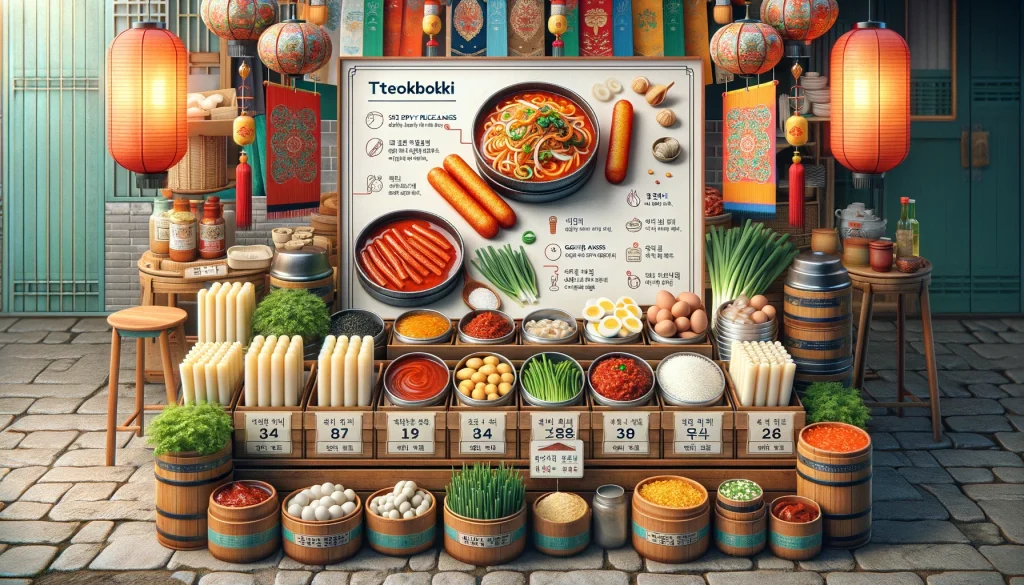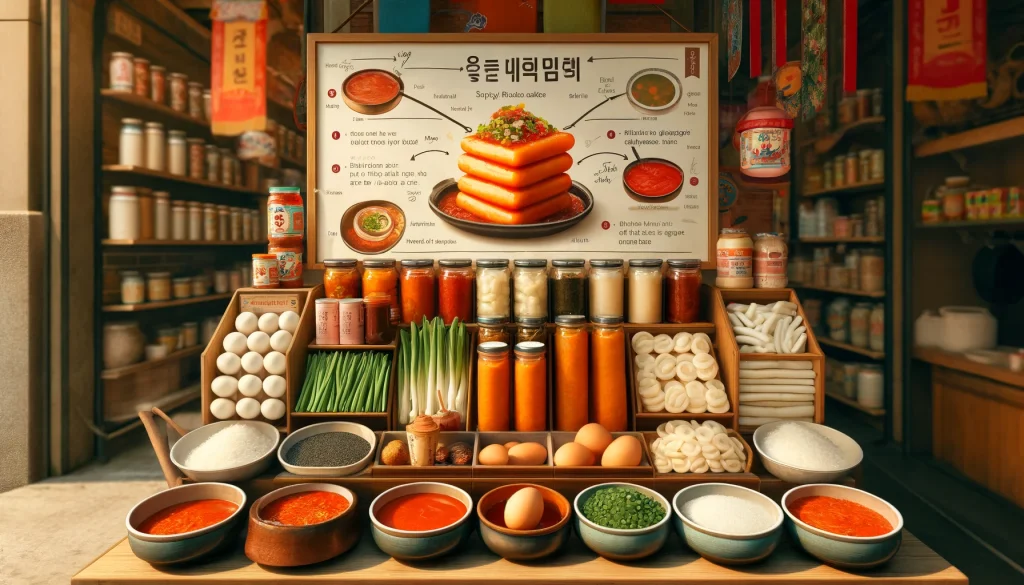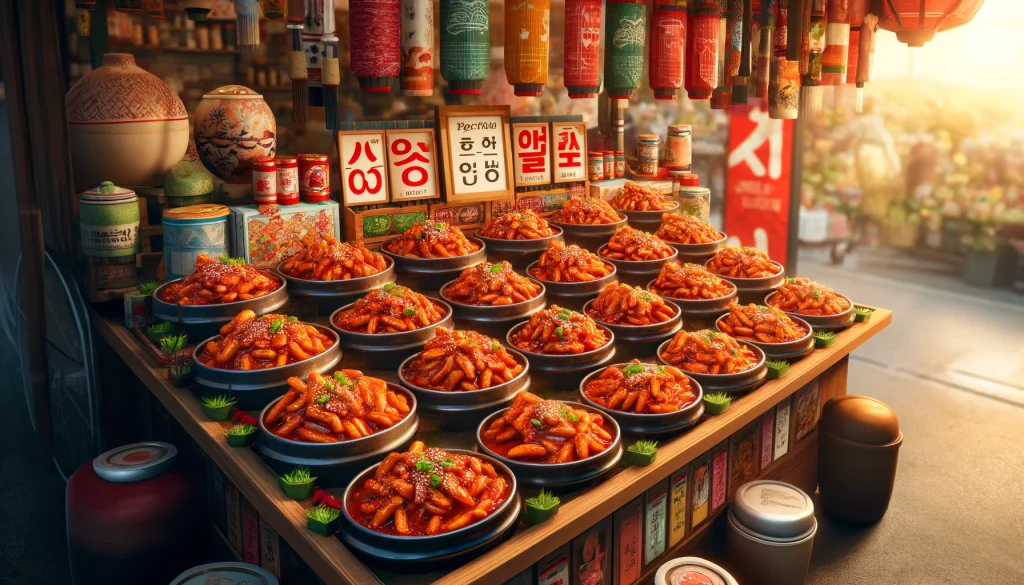As an Amazon Associate I earn from qualifying purchases.
Korean cuisine is renowned for its vibrant flavors and inventive dishes, and among these culinary treasures, Tteokbokki stands out as a quintessential street food delight. This beloved dish, characterized by its chewy rice cakes drenched in a fiery, sweet, and savory sauce, is a staple in Korean street food culture and has captured the hearts of food enthusiasts worldwide. Tteokbokki, or Korean spicy rice cakes, is not just food; it’s a cultural icon, embodying the warmth, tradition, and the ever-evolving tastes of Korea.
Originating from the royal courts of the Joseon dynasty to the bustling streets of contemporary Seoul, Tteokbokki has undergone a fascinating transformation. Its journey from a soy sauce-based dish to the spicy gochujang-laden version we adore today mirrors the dynamic history and adaptability of Korean cuisine. This guide will take you through the essentials of crafting the perfect Tteokbokki at home, offering expert tips, common questions, and the storied history behind this spicy delicacy. Whether you’re a seasoned cook or a curious newcomer to Korean cooking, the journey to mastering Tteokbokki promises to be as rewarding as it is delicious. Join us as we explore the spicy, sweet, and utterly irresistible world of Tteokbokki.
Korean Spicy Rice Cake Recipe

Korean spicy rice cakes, known as Tteokbokki or Ddukbokki, are a popular Korean street food and comfort dish. This dish is known for its spicy, slightly sweet sauce and chewy rice cakes. Here’s a basic recipe for making Korean spicy rice cakes at home:
Ingredients:
- Rice Cakes: 500g (fresh or frozen; if using frozen, thaw them first)
- Fish Cakes: 200g, cut into bite-sized pieces
- Hard-Boiled Eggs: 2-4 (optional)
- Green Onions: 2-3, sliced into 2-inch pieces
- Cabbage: 1 cup, chopped (optional)
- Gochujang (Korean red chili paste): 2-3 tablespoons, adjust to taste
- Gochugaru (Korean red pepper flakes): 1-2 tablespoons, adjust to taste
- Soy Sauce: 1 tablespoon
- Sugar: 1-2 tablespoons, adjust to taste
- Garlic: 2 cloves, minced
- Water: 4 cups
- Sesame Seeds and Sesame Oil (optional, for garnish)
Instructions:
- Prepare the Rice Cakes: If the rice cakes are frozen, thaw them in cold water. If they are particularly hard, you can soak them in warm water for about 10 minutes, then drain.
- Cook the Sauce: In a large skillet or wok, mix water, gochujang, gochugaru, soy sauce, sugar, and minced garlic. Stir well and bring to a simmer over medium heat.
- Add Rice Cakes: Once the sauce is simmering, add the rice cakes. Stir gently to ensure the rice cakes are evenly coated with the sauce. Allow them to cook for about 5 minutes, or until they start to soften.
- Add Vegetables and Fish Cakes: Add the cabbage (if using), fish cakes, and any other additional ingredients you like. Cook for another 5-10 minutes, or until the rice cakes are fully softened and the vegetables are cooked through.
- Adjust Seasoning: Taste the sauce and adjust the seasoning if necessary. If you prefer it spicier, you can add more gochugaru. For more sweetness, add a bit more sugar.
- Add Eggs and Green Onions: If using hard-boiled eggs, add them during the last 2-3 minutes of cooking, just to heat them through. Add the green onions towards the end of the cooking process to maintain their color and crunch.
- Serve: Once everything is cooked through and the sauce has thickened slightly, turn off the heat. Drizzle with a bit of sesame oil and sprinkle sesame seeds on top, if desired. Serve hot.
Tips:
- Adjusting Texture and Thickness: The thickness and spice level of the sauce can be adjusted by adding more water to thin it out or cooking it down to thicken. You can also adjust the amount of gochujang and sugar to balance the spicy and sweet flavors to your liking.
- Variations: Tteokbokki can be customized with various additions like ramen noodles (for Rabokki), cheese on top, or even a seafood mix to make it a more substantial meal.
This recipe is versatile and allows for plenty of customization based on your taste preferences. Enjoy your homemade Tteokbokki!
Expert Tips
Korean Spicy Rice Cakes, known as Tteokbokki (떡볶이), is a popular Korean street food and comfort dish. Here are some expert tips to elevate your Tteokbokki recipe:
- Choice of Rice Cakes: Use fresh rice cakes if possible for the best texture. Fresh rice cakes are soft and chewy. If you’re using dried or refrigerated rice cakes, soak them in warm water for about 20 minutes before cooking to soften them up.
- Anchovy Stock: For the base of the sauce, use a homemade anchovy stock. This stock is made by boiling dried anchovies and kelp (dashima) in water. It adds depth to the flavor of the Tteokbokki. If you prefer a simpler version or a vegetarian option, you can use vegetable broth or water, but anchovy stock will give you the authentic taste.
- Gochujang and Gochugaru: The sauce’s flavor comes from a combination of gochujang (Korean red chili paste) and gochugaru (Korean red chili flakes). Adjust the ratio according to your spice tolerance. For a deeper flavor, you can add a bit of soy sauce and a small amount of sugar to balance the spiciness.
- Additions for Complexity: To add complexity and texture to your Tteokbokki, consider including fish cakes, boiled eggs, and green onions. For a modern twist, some people add ramen noodles, cheese, or even seafood.
- Control the Consistency: The consistency of the sauce can make or break your Tteokbokki. It should be thick enough to coat the rice cakes nicely but not too thick that it becomes gloopy. You can adjust the consistency by adding more stock or water if it’s too thick or simmering longer if it’s too watery.
- Taste and Adjust: Taste your sauce as you cook and adjust the seasoning if needed. Some prefer a sweeter taste, while others might want it spicier. A little bit of sugar can help balance the flavors, especially the spiciness.
- Serving: Tteokbokki is best served hot, right off the stove. The texture of the rice cakes can change if they’re left to sit for too long, becoming too soft or hard.
- Experiment with Sauces: Besides the traditional spicy sauce, there are variations like the soy sauce-based version (Gungjung Tteokbokki) or cream sauce Tteokbokki. Feel free to experiment with different sauces according to your preference.
Remember, the key to the perfect Tteokbokki lies in balancing the flavors and textures to your taste. Don’t be afraid to adjust ingredients and explore variations!
Why This Recipe Is Just So Good…

The Korean Spicy Rice Cake (Tteokbokki) recipe stands out for several reasons, making it an irresistibly good dish that appeals to many. Here’s why this recipe is so beloved:
- Complex Flavors: Tteokbokki offers a perfect balance of sweet, spicy, and savory flavors. The gochujang (Korean red chili paste) provides a deep, spicy base, while sugar or a bit of honey adds sweetness to counter the heat. The umami from fish cakes and anchovy stock rounds out the flavor profile, creating a complex and addictive taste.
- Varied Textures: The dish features a delightful contrast in textures, from the chewy and soft rice cakes to the crisp vegetables and the tender fish cakes. This variety keeps each bite interesting and satisfying.
- Customizable: Tteokbokki is incredibly versatile. You can adjust the level of spiciness, add different proteins like boiled eggs or seafood, or include vegetables for added nutrition and flavor diversity. This flexibility allows the dish to cater to a wide range of palates and preferences.
- Comforting Warmth: The dish’s warmth and spiciness make it particularly comforting, especially during colder months. It’s a hearty, satisfying meal that warms you up from the inside out.
- Cultural Experience: Eating Tteokbokki is not just about enjoying a meal; it’s also a way to experience Korean culture. It’s a popular street food in Korea, often associated with childhood memories for many Koreans. For others, it’s a way to explore the flavors and traditions of Korean cuisine.
- Social Dish: Often shared among friends or family, Tteokbokki is a social dish that brings people together. It’s common to see it enjoyed in groups, adding a communal and interactive element to the dining experience.
- Easy and Quick to Prepare: Despite its complex flavors, Tteokbokki is relatively simple and quick to prepare, making it a great option for a satisfying meal or snack without much hassle.
The combination of these factors—flavor complexity, texture variety, customizability, comforting warmth, cultural significance, social nature, and ease of preparation—explains why the Korean Spicy Rice Cake recipe is so good and loved by many around the world.
Storage Instructions
Storing Korean Spicy Rice Cakes (Tteokbokki) properly is important to maintain its taste and texture for later enjoyment. Here are some storage instructions:
- Cool Down: Allow the Tteokbokki to cool to room temperature before storing. However, don’t leave it out too long as it can spoil. Ideally, you should aim to refrigerate it within two hours of cooking.
- Airtight Container: Transfer the Tteokbokki into an airtight container. This will help to prevent it from absorbing other flavors from the fridge and also maintain its moisture.
- Refrigeration: Once stored in an airtight container, you can keep the Tteokbokki in the refrigerator. It should last for 1-2 days. The texture of the rice cakes might change a bit, becoming slightly harder or more chewy, but they will still be enjoyable.
- Freezing: For longer storage, Tteokbokki can be frozen, although this might further affect its texture. To freeze, place the Tteokbokki in a freezer-safe, airtight container. It can last for up to a month. However, note that upon reheating, the rice cakes might become much softer and the sauce might separate.
- Reheating: To reheat refrigerated Tteokbokki, you can use a microwave or a stovetop. Add a little bit of water or broth when reheating to ensure the sauce doesn’t dry out and to help revive the texture of the rice cakes. For frozen Tteokbokki, it’s best to let it thaw in the refrigerator overnight before reheating. Heat it slowly over low to medium heat, stirring occasionally and adding liquid as needed.
Remember, the quality of Tteokbokki is best when eaten fresh, and the texture of the rice cakes is likely to change upon reheating. Therefore, it’s recommended to only make as much as you can consume in one or two sittings for the best experience.
Frequently Asked Questions (FAQ)

Q: What is Tteokbokki?
A: Tteokbokki is a popular Korean street food dish featuring chewy rice cakes coated in a thick, spicy, and sweet sauce. It’s known for its bold flavors and is often garnished with scallions, sesame seeds, and sometimes fish cakes.
Q: What ingredients do I need for Tteokbokki?
A: The basic ingredients for Tteokbokki include cylindrical rice cakes (garaetteok), fish cakes, scallions, and a sauce made from gochujang (Korean red chili paste), gochugaru (Korean red chili flakes), sugar, and soy sauce. Some recipes might also include garlic, onion, and hard-boiled eggs.
Q: Can I make Tteokbokki less spicy?
A: Yes, you can adjust the spiciness of Tteokbokki by reducing the amount of gochujang and gochugaru. Alternatively, adding more sugar or a bit of honey can help balance the heat with sweetness.
Q: How can I make Tteokbokki if I don’t have rice cakes?
A: While rice cakes are central to Tteokbokki, you can experiment with other ingredients like thick udon noodles or sliced rice rolls (tteokguk tteok) as alternatives. The texture and experience will differ, but the sauce can still provide a similar flavor profile.
Q: Is Tteokbokki suitable for a vegetarian diet?
A: Tteokbokki can be adapted for vegetarians by omitting fish cakes and using vegetable broth instead of anchovy or seafood broth. You can add more vegetables like mushrooms, carrots, and cabbage for variety and texture.
Q: How do I store leftover Tteokbokki, and how long will it last?
A: Leftover Tteokbokki can be stored in an airtight container in the refrigerator for 1-2 days. The texture of the rice cakes might become firmer over time. Reheat gently with a splash of water to help loosen the sauce and revive the rice cakes’ texture.
Q: Can Tteokbokki be frozen?
A: Freezing Tteokbokki is possible, but it might significantly alter the texture of the rice cakes, making them softer or mushier once reheated. If you choose to freeze it, store it in a freezer-safe airtight container and consume within a month for the best quality.
Q: How do I make Tteokbokki sauce from scratch?
A: To make Tteokbokki sauce, combine gochujang, gochugaru, sugar, soy sauce, minced garlic, and a bit of water or broth in a pan. Cook this mixture on low heat until it thickens slightly and the flavors meld together. Adjust the seasoning according to your taste, adding more sugar or soy sauce if needed.
Q: What side dishes pair well with Tteokbokki?
A: Tteokbokki pairs well with various Korean dishes such as Kimchi, Korean fried chicken, Sundubu-jjigae (soft tofu stew), or a simple vegetable salad. These side dishes can help balance the spiciness and richness of the Tteokbokki.
Q: Can I add cheese to Tteokbokki?
A: Yes, adding cheese to Tteokbokki has become a popular variation. Sprinkle shredded mozzarella or place slices of cheese on top of the Tteokbokki while it’s still hot. The cheese melts into the sauce, adding a creamy texture and balancing the dish’s spiciness.
Q: What is the origin of Tteokbokki, and how has its recipe evolved over time?
A: Tteokbokki originated from Korea and has a rich history dating back to the Joseon Dynasty. Initially, it was a stir-fried dish consisting of garaetteok (a type of cylindrical rice cake), meat, vegetables, and soy sauce. The modern, spicy version of Tteokbokki that we know today, which uses gochujang (red chili paste) as its base, emerged in the mid-20th century. Over time, various adaptations have been made, leading to the creation of different styles of Tteokbokki, including those with cheese, seafood, and even cream-based sauces.
Q: What types of rice cakes are best for Tteokbokki, and how do they affect the dish’s texture?
A: The best type of rice cakes for Tteokbokki are fresh, soft, cylindrical rice cakes known as garaetteok. These rice cakes are chewy and absorb the sauce well, enhancing the dish’s flavor and texture. Frozen or refrigerated rice cakes can also be used, but they should be soaked in warm water before cooking to soften them. The texture of the rice cake is crucial to the dish, with the ideal texture being soft and chewy without being too hard or mushy.
Q: How do you achieve the perfect balance of flavors in Tteokbokki sauce?
A: Achieving the perfect balance of flavors in Tteokbokki sauce requires a combination of spicy, sweet, and savory elements. The base typically includes gochujang (Korean red chili paste) for spice, a small amount of sugar or honey for sweetness, and soy sauce for depth and umami. Taste testing during cooking is crucial for balancing these elements according to personal preference. Some recipes also include garlic, ginger, or a dash of sesame oil for additional layers of flavor.
Q: Can Tteokbokki be made vegetarian, and what substitutions would you recommend?
A: Yes, Tteokbokki can easily be adapted for a vegetarian diet. Instead of anchovy stock, use vegetable broth or water as the base for the sauce. For additional protein, you can substitute fish cakes with fried tofu, mushrooms, or other vegetables like broccoli, carrots, and spinach. Ensure that the gochujang and other ingredients used do not contain any animal products, as some brands may vary.
Q: What are some common mistakes to avoid when making Tteokbokki?
A: Some common mistakes include not soaking dried or refrigerated rice cakes long enough, resulting in a too hard or chewy texture; overcooking the rice cakes, which can make them mushy; adding too much gochujang or gochugaru, which can overpower the dish making it excessively spicy; and not tasting the sauce during cooking to adjust the seasoning. Also, avoid using a weak broth as it can result in a lackluster sauce. Taking care to balance these elements will result in a more successful Tteokbokki.
Conclusion
In conclusion, Korean Spicy Rice Cake, or Tteokbokki, stands as a testament to the rich culinary heritage and versatility of Korean cuisine. This beloved street food, with its chewy rice cakes drenched in a vibrant, spicy sauce, not only offers a window into Korea’s cultural palate but also invites food enthusiasts to explore the depth of flavors and textures that define Korean cooking. The adaptability of the recipe allows for numerous variations, catering to different dietary preferences and spice tolerances, making it a universal favorite. Whether you’re a seasoned cook or a novice in the kitchen, Tteokbokki’s straightforward preparation process and its comforting, heartwarming taste promise a rewarding culinary adventure. As we embrace the global tapestry of flavors, Tteokbokki remains a shining example of how traditional dishes can transcend cultural boundaries, bringing people together in the shared experience of enjoying good food. So, the next time you’re seeking a dish that packs a punch and delivers unbridled joy with each bite, remember the humble yet mighty Tteokbokki, a dish that truly embodies the spirit and warmth of Korean cuisine.






